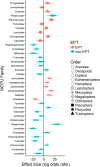Stream acidification and reduced aquatic prey availability are associated with dietary shifts in an obligate riparian Neotropical migratory songbird
- PMID: 30002974
- PMCID: PMC6037135
- DOI: 10.7717/peerj.5141
Stream acidification and reduced aquatic prey availability are associated with dietary shifts in an obligate riparian Neotropical migratory songbird
Abstract
Streams and their surrounding riparian habitats are linked by reciprocal exchanges of insect prey essential to both aquatic and terrestrial consumers. Aquatic insects comprise a large proportion of total prey in riparian habitats and are opportunistically exploited by terrestrial insectivores; however, several species of songbirds are known to preferentially target aquatic prey via specialized foraging strategies. For these songbirds, reduced availability of aquatic insects via stream acidification may result in compensatory changes in provisioning during the nesting period, thereby influencing both adult and nestling diet composition. In this study, we used DNA metabarcoding to test the hypothesis that an obligate riparian Neotropical migratory songbird, the Louisiana Waterthrush (Parkesia motacilla), expands its diet to compensate for the loss of preferred aquatic prey taxa (primarily pollution-sensitive Ephemeroptera, Plecoptera, and Trichoptera) as a result of stream acidification. Our results revealed that both adult and nestling waterthrush exhibited an increase in dietary richness and niche breadth resulting from the consumption of terrestrial prey taxa in acidified riparian habitats. In contrast, compensatory dietary shifts were not observed in syntopic Neotropical migrant species known to primarily provision terrestrial prey taxa. In addition to providing support for our hypothesis that waterthrush compensate for stream acidification and aquatic prey limitations by expanding their diet, our findings highlight the vulnerability of Louisiana Waterthrush to anthropogenic disturbances that compromise stream quality or reduce the availability of pollution-sensitive aquatic insects.
Keywords: DNA metabarcoding; EPT; Louisiana Waterthrush; Macroinvertebrates; Next-generation sequencing; Resource subsidies.
Conflict of interest statement
Tim Nuttle is an ecologist at Civil and Environmental Consultants, Inc. Nathan L. Brouwer is a Research Associate at the National Aviary. Steven C. Latta is the Director of Conservation and Field Research at the National Aviary.
Figures



References
-
- Arcese P, Smith JN. Effects of population density and supplemental food on reproduction in song sparrows. The Journal of Animal Ecology. 1988;57:119–136. doi: 10.2307/4768. - DOI
-
- Barbour MT, Gerritsen J, Snyder BD, Stribling JB. Rapid bioassessment protocols for use in streams and wadeable rivers: periphyton, benthic macroinvertebrates and fish, second edition. EPA 841-B-99-002. US Environmental Protection Agency Office of Water; Washington, D.C.: 1999.
-
- Bates D, Maechler M, Bolker B, Walker S. Fitting linear mixed-effects models using lme4. Journal of Statistical Software. 2015;67:1–48. doi: 10.18637/jss.v067.i01. - DOI
-
- Baxter CV, Fausch KD, Carl Saunders W. Tangled webs: reciprocal flows of invertebrate prey link streams and riparian zones. Freshwater Biology. 2005;50:201–220. doi: 10.1111/j.1365-2427.2004.01328.x. - DOI
LinkOut - more resources
Full Text Sources
Other Literature Sources

